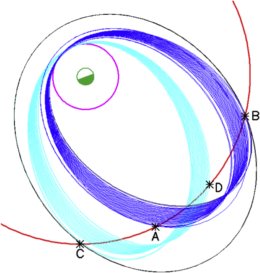Daring high-speed, low-altitude maneuvers and scientists wrestling with questions of life elsewhere in the universe: these are both elements found not only in Hollywood blockbusters, but also in a recently proposed mission to Saturn’s moon Enceladus.
But Why, Some Say, (This) Moon?

A schematic of the interior structure of Enceladus as best understood today. The plumes are launched from the “Tiger Stripes” in the southern hemisphere. [Cable et al. 2021]
Some of Cassini’s most exciting finds were specific particles and molecules in the plumes that are usually associated with hydrothermal vents here on Earth, where strange life forms survive just fine even without sunlight. However, Cassini was limited both by the technology of its time and by its design: since its engineers didn’t know the plumes existed before it launched, it carried no instruments designed specifically to investigate them.

Orbital trajectory around Saturn, which is represented by the green circle. Enceladus’s orbit is marked in pink, Titan’s is shown in red. Two sets of spacecraft orbits that would allow for close flybys of Enceladus at different mission phases are marked in purple and cyan. [Mousis et al 2022]
Mixed Blessings
Unfortunately for the proposal team, ESA did not select Moonraker as one of the four mission concepts for further development, citing difficulties keeping the cost and mission duration within the scope of a Medium-class mission. However, what was surely disappointing news at the time seems much rosier in hindsight: since crafting this initial modest mission plan, ESA announced that they’ll soon seek proposals for much larger, €1 billion missions reliant on larger rockets. The team now plans to regroup, add a few more instruments and science goals to their concept, then resubmit a more ambitious proposal for this latest opportunity.
While it’s impossible to say which missions will ultimately get selected, it remains possible that we’ll celebrate the earliest part of the second half of this century with a robotic dive through these distant, frigid jets.
Citation
“Moonraker: Enceladus Multiple Flyby Mission,” O. Mousis et al 2022 Planet. Sci. J. 3 268. doi:10.3847/PSJ/ac9c03
